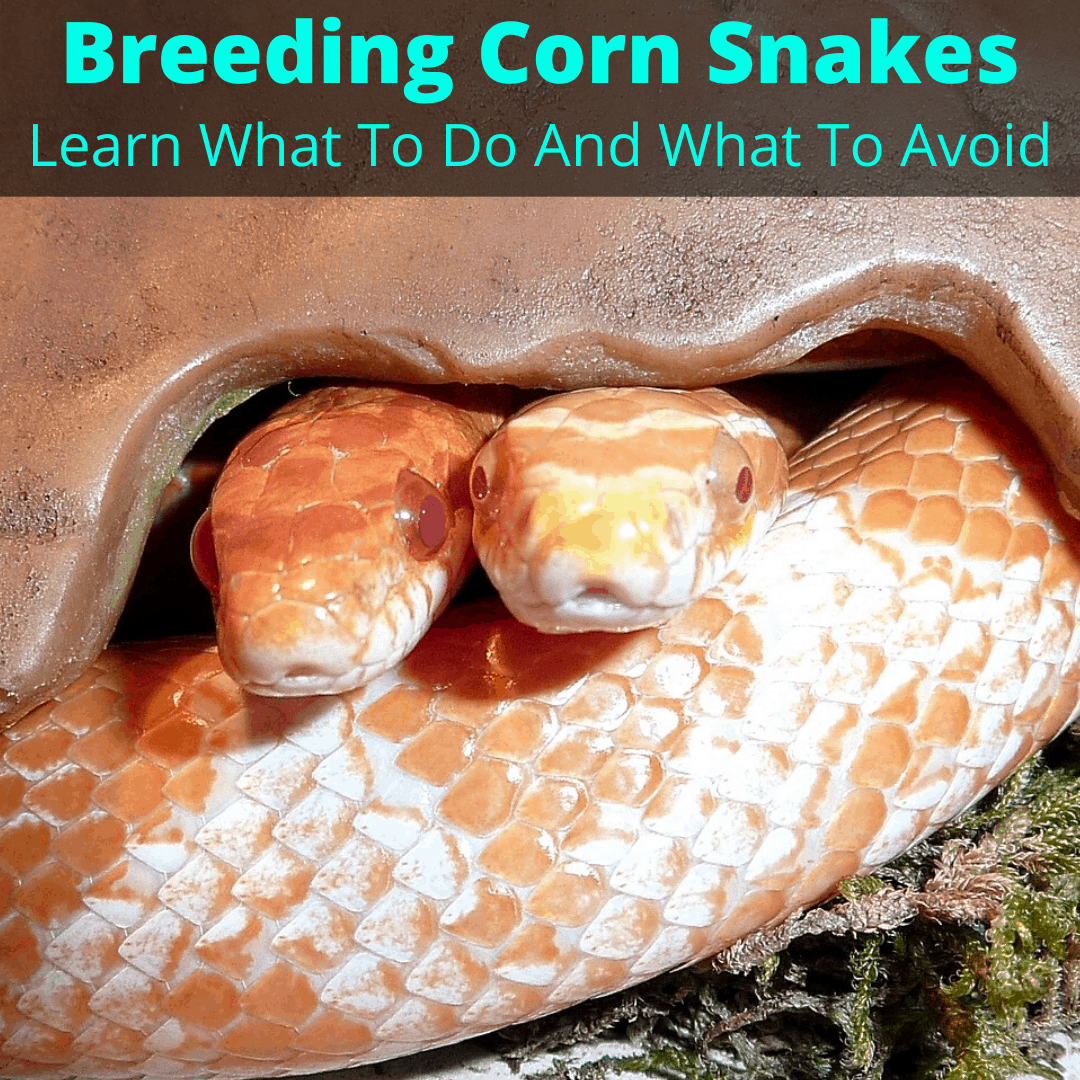
Some people are obsessed with breeding corn snakes.
Trying to create new and cool morphs can easily turn into an addicting hobby.
But it can also be a lucrative business.
Given the demand for corn snake morphs, beign a professional corn snake breeder can earn you a nice chunk of change.
But we’re getting ahead of ourselves.
If you’re thinking about getting into the breeding of corn snakes, there are some things you need to know.
Overall, they’re fairly easy to breed, but you have to make sure to provide the right conditions. And that’s really all there is to it, until you get into breeding specific morphs. We’ll cover that a bit below. First, let’s begin by discussing brumation.
Table of Contents
Breeding Corn Snakes
How to you know when your corn snakes are ready to breed?
Follow the so-called rule of three: three years old, three feet long and three hundred grams heavy. If those requirements are satisfied, your snake is in shape for breeding.
Breeding Corn Snakes Without Brumation
Brumation is a natural process in snakes which is pretty much equivalent to hibernation in mammals. Opinions are quite divided when talking about the necessity of brumation.
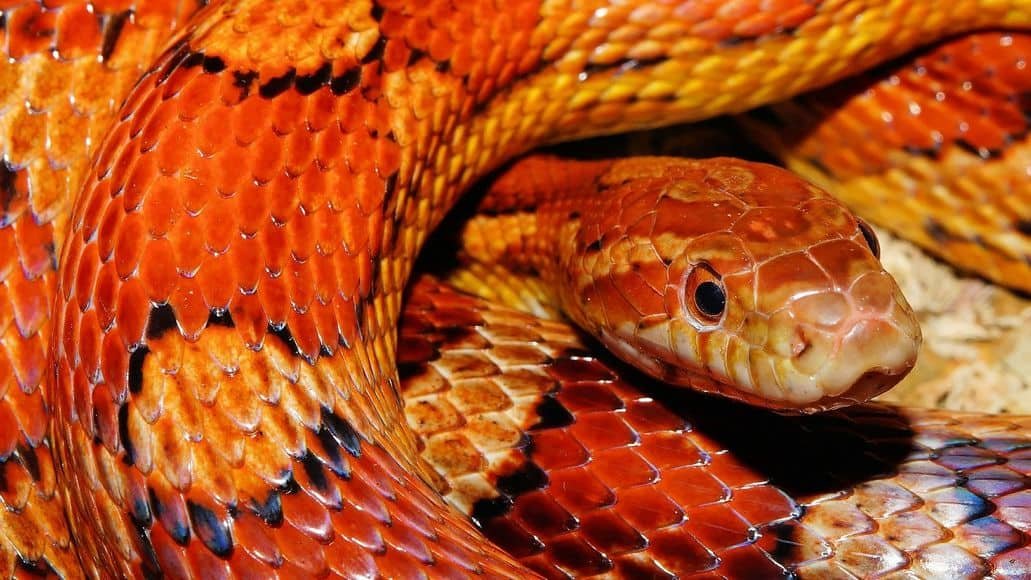
In nature, brumation prepares snakes for the next season. It triggers ovulation in females and production of viable sperm in males. Environmental conditions tell snakes when to begin and end brumation.
Snakes that live in captivity may skip the brumation period due to the artificial environmental conditions. If you do not alter their environment (e.g. cooler temperatures, shorter days, etc.) they will not enter brumation. The choice is up to you.
Some breeders ask whether it is necessary to brumate, in order to accomplish successful mating, fertile eggs, and healthy offspring.
More important than brumation itself, is that the sexes are separated before mating season. In other words, males and females shouldn’t be spending time together in the same enclosure before the mating season starts.
Since the brumation period starts in mid-November and ends by the end of February, if you want to skip the brumation period, simply keep the environmental conditions in the cage the same. In other words, do not give your snake winter-like conditions.
What are the risks?
The major risk of skipping brumation before breeding is that your snakes simply won’t breed. But most snakes breed just fine without brumation.
Our advice is to try without brumation. It is easier. But if you do end up having them brumate, it also has its advantages,
It saves you money, for one, since you won’t need to buy food, supplements, and substrates for a few months (snakes don’t eat during brumation).
If the snakes do not breed, then provide them a brumation period and try breeding them again.
Corn Snake Breeding Season Behavior
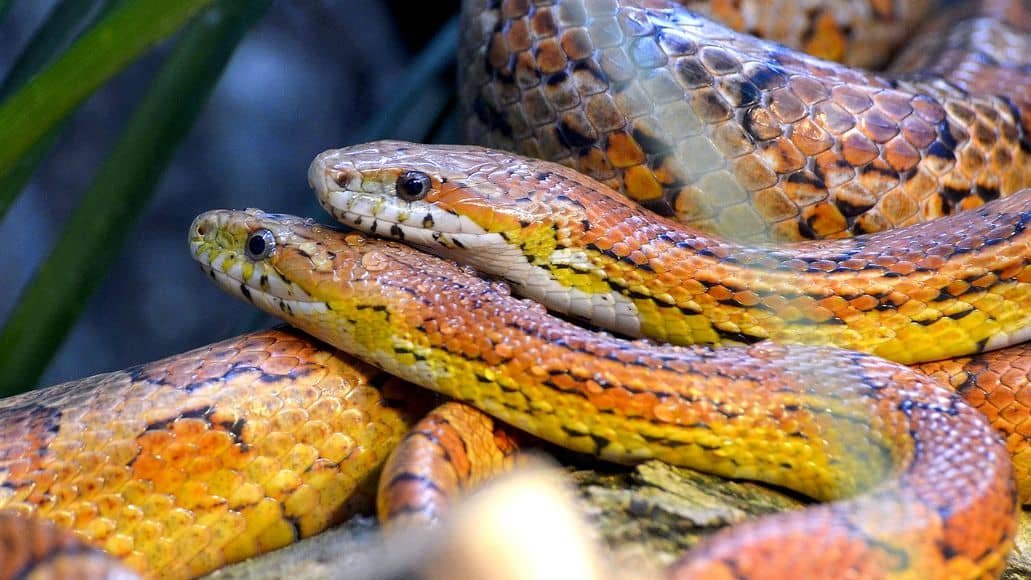
After the brumation period, corn snakes are ready to reproduce. Some say to wait two or three weeks, while others say to wait until after the fifth meal, for them to start mating.
An important sign that occurs before mating is shedding. Males and females are still separated at that time.
Shedding is a natural process of growing new skin and taking off old layers of skin. There are several signs to indicate your corn snake is about to shed.
The color of the eyes changes and becomes somewhat bluish. Old skin becomes dull and belly parts take on a pinkish tone. Other signs include appetite change, and an increased desire to hide and become overly defensive.
The appearance of female corn snakes changes when they are ready for breeding. You’ll notice swelling in the posterior parts of her body. This indicates that ovulation happened. In other words, she has a lot of egg cells in her body.
She may look like she is slightly overfed, but you’ll notice that the swollen area are relatively soft and located laterally in her posterior parts.
If a female snake is ready for mating, the male snake is ready too. After placing them together you’ll notice the male becoming active and very eager to interact with a new female in his surrounding. Sometimes males may make specific body language moves that look a lot like muscle spasms.
After noticing the female, the male comes closer and they both line up their bodies. Their tails move a bit up or wrap around each other. Those positions ensure the most intimate contact so the hemipenes may penetrate the female’s body.
In some cases, when the breeder is not quite sure about sexes, it can happen that two males get put together by mistake. If this happens, you will notice aggressive fighting and even biting, just like a strength contest. Don’t fret, just separate the males.
Incubating Corn Snake Eggs
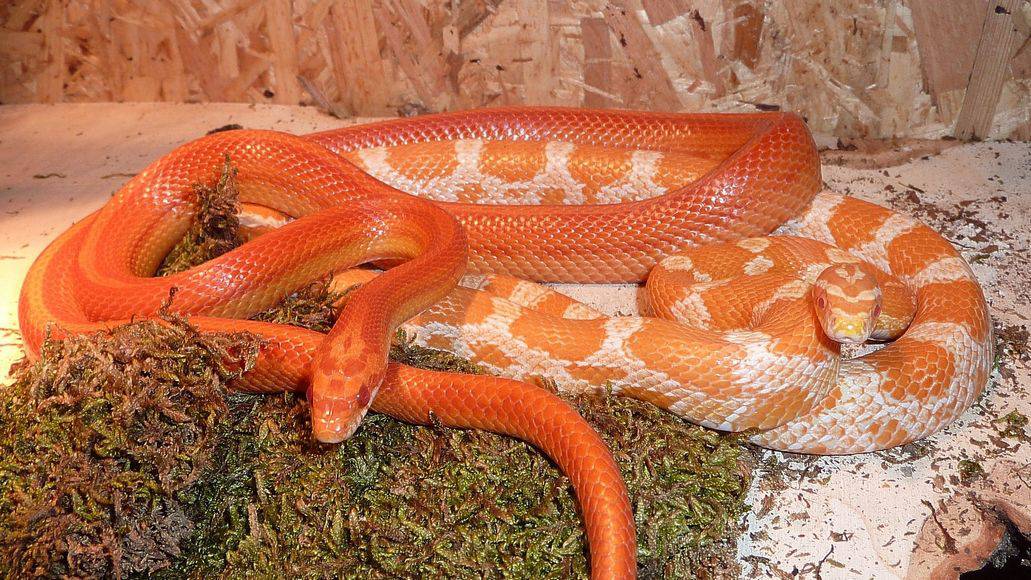
The next step is incubation. It is a simple process of setting the correct artificial conditions to aid in maturation of the eggs.
What you need is a container with a removable lid and a medium placed inside. Our post on the best snake racks reviews several such containers.
Several substances may be used as a medium: vermiculite, peat moss or perlite. Those materials all provide good insulation, making them great to preserve heat.
Before placing the medium in the container you must clean it well. Use any kind of liquid disinfectant for cleaning.
After the female has laid her eggs, remove them gently. Be careful since the eggs are softer than bird’s eggs. Try to maintain the same orientation when transporting and then placing them in the container. In other words, don’t jostle the contents of the eggs too much.
Place the eggs in the medium then cover the container with the lid. Provide good ventilation to prevent mold from forming.
Now you are ready to place the container in the incubator. A specialized reptile incubator will provide the desired temperature during the next couple of weeks. Maintain a temperature of 78 to 84° F and expect the babies in the next two months.
In some rare situations, you may need to be a little more patient, even if you followed the exact instructions. Don’t panic, just maintain the same temperature until the eggs hatch.
The incubator is not required. If you don’t have one you can go ahead and place the container anywhere else that meets the temperature needs of the eggs. That means that you can place it anywhere, as long as the temperature is at least 78°F and does not fluctuate.
Monitor the eggs. You should check up on them a few times a week. Try ventilating once a fortnight, since eggs also breathe. In addition, maintain optimal humidity levels.
Humidity Required For Incubation
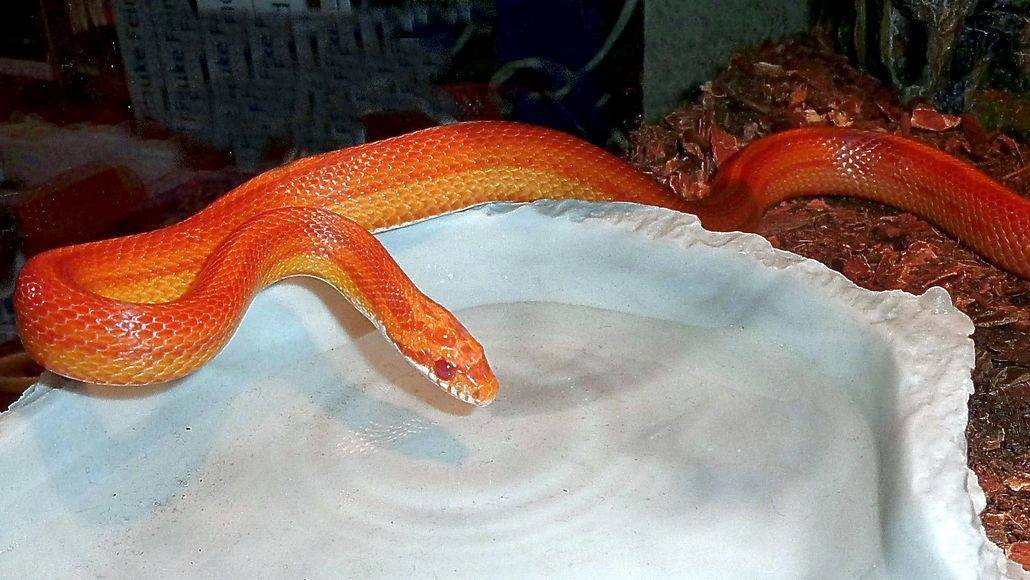
Humidity is an important parameter for incubation. It helps temperature spread more effectively provides the eggshell with enough moisture. Eggs are prone to dehydration if the air does not contain enough moisture.
You should adjust the incubator to the desirable temperature and humidity a day before placing the eggs, in order to ensure constant levels.
Use a hygrometer to measure humidity. The best reptile hygrometers give you constant, accurate humidity readings.
The ideal humidity range is 70% to 90%. That said, some breeders feel that a higher humidity level is more effective. Note that when adjusting temperature, you indirectly adjust humidity as well.
If the humidity and temperature levels are higher, there’s a bigger chance that that offspring will be small but aggressive. When these parameters are lower, the baby corn snakes may be calmer and slightly bigger than average.
To provide humidity, you’ll need water and a medium which is capable of absorbing the water (such as vermiculite or perlite). For the best effect, try adding water to the medium until it becomes kind of sticky.
At a certain temperature level, the air in the container is saturated. As the temperature rises, the water vapor is transferred and the eggs are moisturized. Keep the humidity over 70%. Although some suggest higher levels are more effective, we don’t recommend going above 90%.
Make sure to provide openings for ventilation. The air should also be refreshed every 2 to 3 days.
Note: Before including eggs in the process of incubation make sure that you remove the slugs (unfertilized aggs). An easy way of checking which ones are fertilized is to place them near a light. You will see tiny marks in fertilized eggs. Those are the blood vessels. Remove eggs that do not have those.
Corn Snake Laying Eggs Without Mating
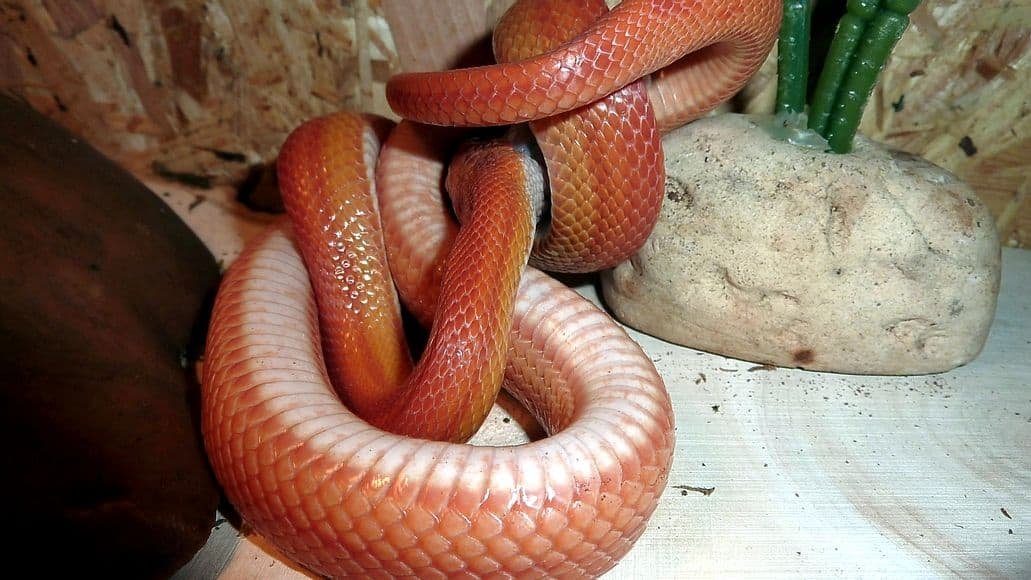
Parthenogenesis, or virgin birth, is a common phenomenon among some species. It happens to insects, sharks, some birds, arachnids, some reptiles, and plants.
It is believed that it occurs in older females that have never mated, or did so long time ago. It is a natural mechanism of continuing the species in conditions where the female lacks male reproductive material, such as animals living in captivity. Some call it natural cloning.
We are not yet sure how it actually happens and what triggers it. It is believed that hormonal (dis)balance has a certain influence, but it is not proven. It is also suspected that some bacterial or viral infections may trigger this process. Some believe it occurs as a product of a genetic mistake.
What happens in the body? A cell that was formed at the same time the eggs were, starts behaving like sperm and carries out fertilization.
In other words, the mother is the only one providing genetic material for her offspring. That means the children inherit the mother’s genes and characteristics only. That applies also to sex. The products of parthenogenesis are always female, since there are no male chromosomes.
Don’t be afraid if it happens to your snake who’s been living with you for years with no boyfriends at all. The offspring is normal and healthy, although they may be a bit smaller than average.
Some breeders noticed that sometimes parthenogenesis happens, even if a male is present. There is no explanation for this phenomenon as of yet.
Male Corn Snake Breeding Size
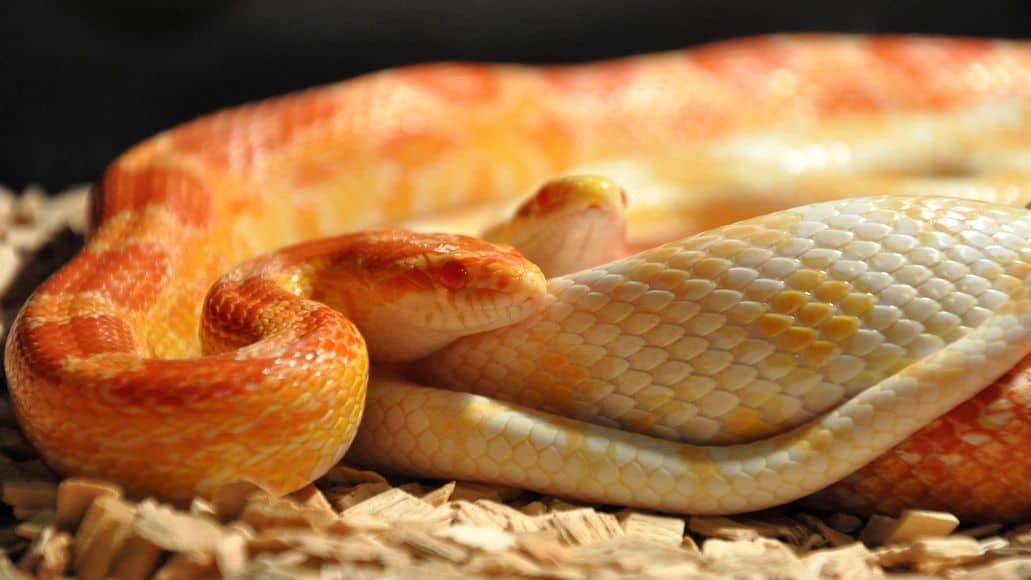
Corn snakes, in general, tend to be 27.5 to 47 inches long. Males are naturally bigger than females. This is one way to determine the gender of your corn snake. But it’s not very accurate.
There are also significant differences in size between snakes kept in captivity and wild ones. Those kept in vivariums are a bit smaller, regardless of sex.
Obviously, environment has an impact on size. And this is true even as early as incubation. As mentioned, if the temperature and humidity are lower during incubation, the future offspring may be bigger than usual and also a bit sluggish. The opposite is true for higher temperature and humidity.
Males tend to be bigger, because of their hormones. More testosterone affects food intake and indirectly muscle mass. The more food they eat the more developed the muscles become, so the bigger they look.
They also grow faster, the more they eat. How fast do corn snakes grow? About 1 to 2 inches a month, when they are not yet mature.
Even more important than food is the growth hormone produced by the pituitary gland. This hormone regulates growth in complex organisms. Its concentrations are genetically determined and correlated to other hormones so they function altogether as a feedback mechanism.
Since corn snakes are carnivores their diet is protein based. Stimulated by testosterone, those proteins are used for muscle growth, so males appear bigger and longer.
In the wild, natural selection also plays a role. Males that are bigger and stronger tend to win the right to mate with a female, thus passing on their genetic material. This does not have much, if any, effect in captivity.
Genetics Is Not The Only Factor
Apart from genetics, and the environmental conditions during incubation, the space you give a corn snake also determines how large it gets, to some degree. They will only grow to their maximum size if they have enough room, so the enclosure must be big enough.
The rule of thumb says that the height of the vivarium should be one-third of the snake’s length, with one square foot of floor space for every foot of snake.
Corn Snake Morphs
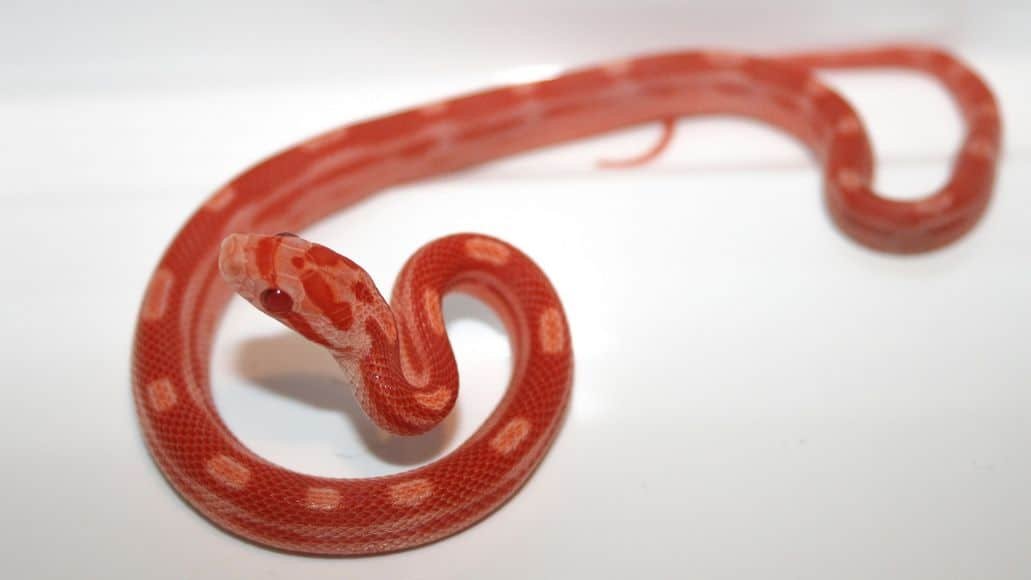
One of the coolest aspects of breeding corn snakes is the opportunity to combine individuals with various characteristics to create offspring with specific colors and patterns. In other words, you can create designer snakes.
There are more than 700 morphs in the corn snake breed, like the beautiful snow corn snake. According to genetics, the number of combinations is endless. And the more that get combined, the more varieties there are.
Every parent provides a gene for an individual characteristic the children inherit. The chance of expressing each gene in the offspring is given in percentages.
For the dominant characteristics, such as the darker color of the body pattern or darker eye color, only one gene is enough for expressing the specific characteristic. In other words, if a parent is darker colored and another one is pale colored chances are that 3 of 4 children will be dark colored.
But only one of the three dark-colored individuals is the dominant homozygote for a specific characteristic (inherited the same gene for one characteristic). And the other two semi-dark colored children may have one dominant gene from one parent and one recessive gene inherited from another parent. In this state, the recessive gene isn’t expressed, but it can be passed on to another generation.
Recessive characteristics determined by recessive genes are expressed only in the case of recessive homozygotes. It means that a recessive gene needs to be inherited from each parent. Recessive characteristics are pale colored body pattern and pale-colored eyes. Generally speaking, recessive inheritance is most undesirable, since many diseases and conditions are passed on.
Wild types as general phenotypes are the basis for the rest of the other subtypes. As you may notice, all the single recessive types (Amelanistic, Cinder, Diffused, Lavander, Sunrise, Terrazzo) have the pale phenotype.
Single incomplete dominant (or heterozygotes) such as Het Palmento look more pallid than wild type. Even paler Palmento does. Single dominant types (Masque, Tessera) inherit a more colorful pattern with striking pigment. Double, triple and quad traits include two, three or four different characteristics combined in one individual.
Corn Snake Breeding: Final Thoughts
Breeding corn snakes can be a challenging task but it can also be very rewarding. Not only is it fun to create new snakes, it can be quite lucrative as well, if you get it right. The corn snake trade in the US is a bustling business and sought after morphs fetch thousands of dollars. So get breeding!
Leave a Reply